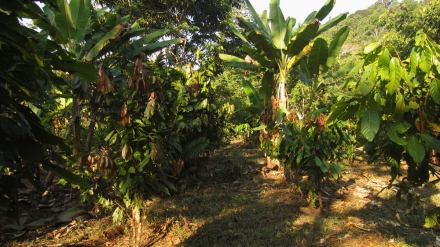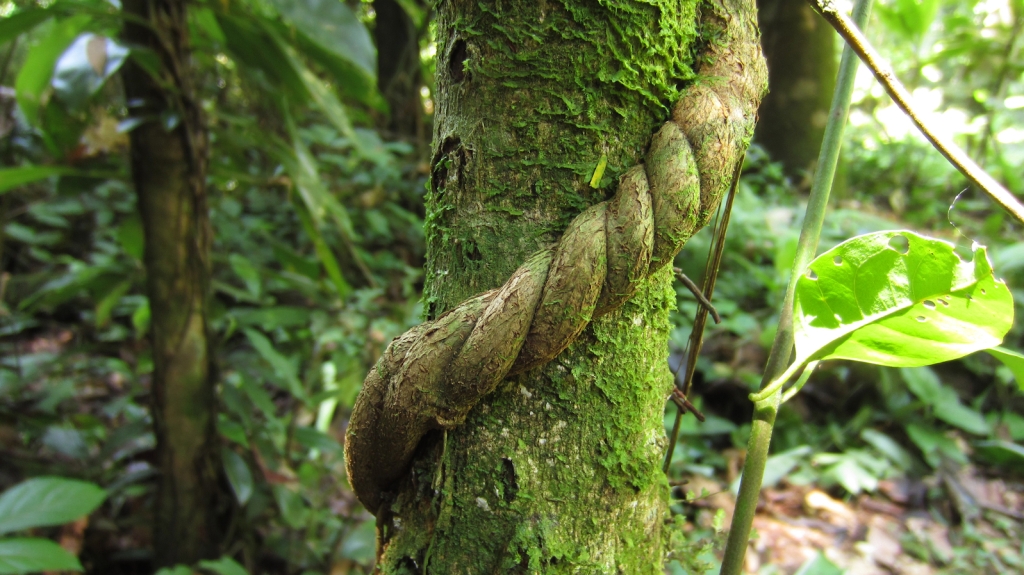Greetings and blessings to everyone reading this. I would like to introduce a very special “product” that we are just beginning to offer. We have small quantities of fresh Banisteriopsis caapi aqueous extract for use in microdosing regimens made with plants grown here at Isulawasi. Our first batch of extract was prepared and completed in the beginning of March 2022.

Note: I will use liana and vine interchangeably. They both refer to woody parts of Banisteriopsis caapi.
Microdosing the extract of the B. caapi liana can be a wonderful way to connect and reconnect with this very special plant. Many do not realize that this liana is the main ingredient of the Pan-Amazonian entheogenic potion most commonly known as ayahuasca. There are many admixture plants used to make ayahuasca, of which Psychotria viridis and Diploterys cabrerana are the most common. However, it is the vine that activates and modulates the effects of these other plants. That is why this Banisteriopsis species is considered one of the most powerful master plants to grow upon this planet!
It has long been known that small, “micro,” doses of the vine can offer many surprising benefits, and can be considered a gradual approach to working with B. caapi. In Buddhism, it was once said that there existed two approaches to access the highest realization – the sudden approach, for me, the equivalent to a full “shamanic” dose of ayahuasca; and the gradual approach, which, for me, is equivalent to a microdose. Perhaps, this is a simplistic way of looking at it, but hopefully, for our purpose it suffices. Microdosing the vine can be very useful for people who need the benefits that this plant has to offer without the complexities of preparing for a couple of “shamanic” sessions. It can serve as a gentle “introduction” to the liana so to speak. This is because a “microdose” is only between one and two tenths of a full dose. So, this allows the participant to have more control through the dosage of the effects and potential benefits of the harmala alkaloids present in the vine. This method of use is an excellent way to gradually introduce this amazing plant medicine and make it’s effects accessible to more people who may not want to traverse the more difficult path just yet. This is not to say that microdosing is an easy path either, nor is it for everybody! It is just a gradual path, for those who are called, to many of the same benefits that others on the “sudden” path may receive. For optimal results, there are recommended “best practices” for the gradual user, too. I’ll speak to this in another article.
Many people may have heard of the amazing physical, mental, emotional, and spiritual effects of potions containing B. caapi vine. Although being a very complex science to tease out exactly which alkaloids produce which effects, it has been apparent for some time now that the harmala alkaloids in the vine are responsible for many of the beneficial effects as well as many of the uncomfortable short-term effects like purging, shaking, and dizziness from high doses. This information can easily be found in the ethnographical and ethnobotanical literature as well as new and on-going ethnopharmacological studies focusing specifically on the effects of the harmala alkaloids found in the vine. For example, there are a number of studies looking at how the beta-carbolines harmine, harmaline, and tetrahydroharmine play an important role in reducing and/or alleviating degenerative neurological disorders such as Parkinson’s, Alzheimer’s, PTSD, Depression, and Anxiety.
There are other noted benefits as well, though mostly anecdotal for now, such as catalyst for neuro-plasticity, inducement of highly creative states, lucid spiritual awareness, and heart-opening interpersonal states of being.
The wonderful thing about microdosing Banisteriopsis caapi is that it offers a powehouse of alkaloidal benefit, and yet is relatively safe to use. There are, however, a few important precautions that need to be understood before beginning your microdose regimen. Even though, here we are talking about very small sub-threshold doses, given that the harmala alkaloids are powerful MAO inhibitors, and frequent usage does have a cumulative effect, it is important to, number one, take breaks after extended use, and number two, exercise caution when combining B. caapi with other types of MAOIs and/or SSRIs such as anti-depressants, lithium, or some kinds of “potentially” toxic consumable products such as aged cheeses, meats, soy products, and other potent ferments.
Although B. caapi is not considered a “classic psychedelic,” that may change in the future as studies on tetrahydroharmine, specifically, come to light. THH, is a very powerful psychedelic on its own, though her visionary effects are subtle in lower doses. I have even heard THH referred to as the “tryptamine of the beta-carboline world.”

So, this is the offer. Unfortunately, for now, these treats are ONLY available within Peru. We currently have 15 ml bottles for sale at S/.40 per bottle, that’s 40 PEN (Peruvian Sol). If you have any inquiries please feel free to contact us.
















